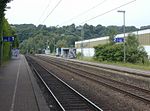Herdecke
Ennepe-Ruhr-KreisTowns in North Rhine-Westphalia

Herdecke (German pronunciation: [ˈhɛʁˌdɛkə] (listen)) is a town in the district of Ennepe-Ruhr-Kreis, North Rhine-Westphalia in Germany. It is located south of Dortmund in the Ruhr Area. Its location between the two Ruhr reservoirs Hengsteysee and Harkortsee has earned it the nickname Die Stadt zwischen den Ruhrseen (lit. The city between the Ruhr lakes). The city is located in the area of the Regionalverband Ruhr (RVR). The two Ruhr lakes as well as the forests on the Ardey heights make the town attractive to tourists. The historic center with its many half timbered houses and the 30-metre-high railway viaduct across the Ruhr valley are two more landmarks.
Excerpt from the Wikipedia article Herdecke (License: CC BY-SA 3.0, Authors, Images).Herdecke
Uferstraße,
Geographical coordinates (GPS) Address Nearby Places Show on map
Geographical coordinates (GPS)
| Latitude | Longitude |
|---|---|
| N 51.4 ° | E 7.4333333333333 ° |
Address
Uferstraße 3
58313 , Nacken
North Rhine-Westphalia, Germany
Open on Google Maps








